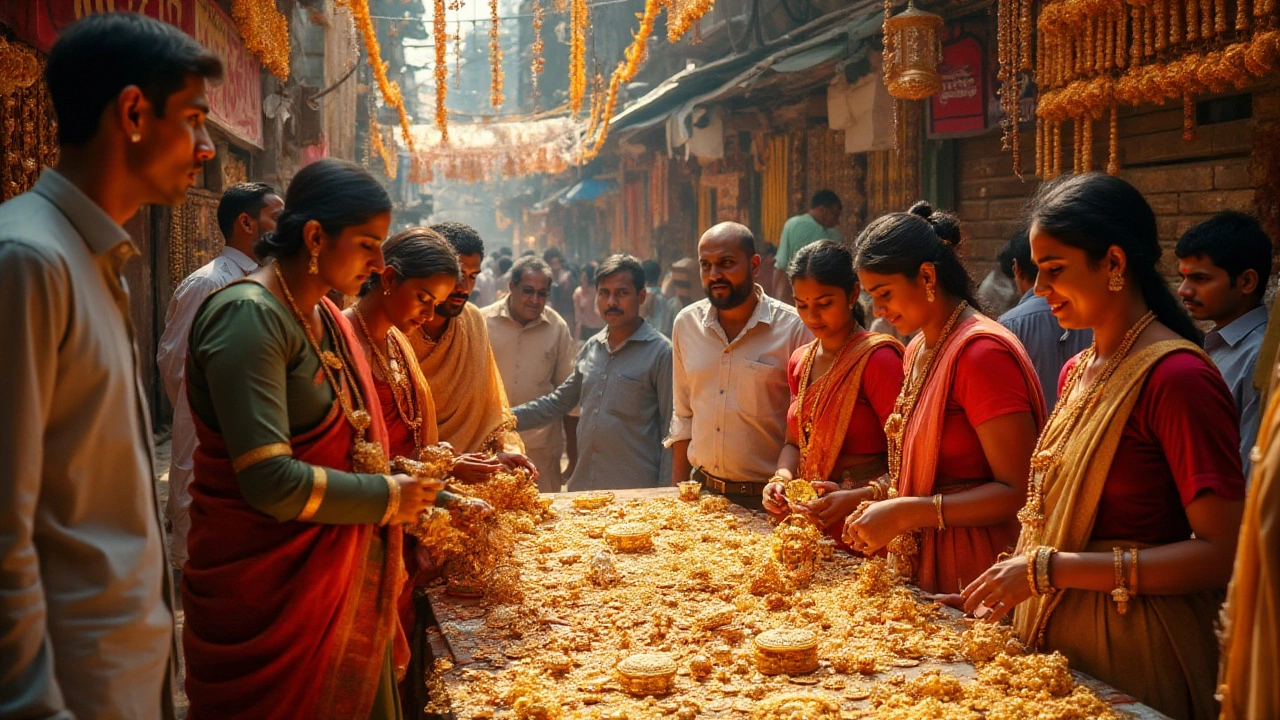Gold has long been a cornerstone in India's cultural and economic landscape, holding a unique position as both a financial asset and a symbol of wealth. It's particularly evident in the realm of temple jewellery, revered not just for its material value but for its artisan craftsmanship and historical lineage.
One might find that gold prices in India are often comparably lower than in other regions due to various factors. From hefty import duties to fluctuating currency exchange rates, several economic components contribute to this phenomenon. Understanding the nuances behind gold pricing can open doors for savvy investments or creating exquisite jewellery collection pieces.
- Cultural Significance and Demand
- Role of Import Duties
- Impact of Exchange Rates
- Local Craftsmanship and Material Costs
- Economic Factors and Purchasing Power
- Seasonal Trends and Festive Influence
Cultural Significance and Demand
The allure of gold prices in India cannot be fully grasped without delving into its profound cultural importance. For centuries, gold has been deeply woven into the very fabric of Indian society. It symbolizes prosperity, divine blessings, and an essential part of every monumental life event. Weddings, festivals, and religious ceremonies are practically incomplete without the shimmering presence of gold, especially in the form of exquisite temple jewellery. This kind of jewellery, known for its elaborate designs and historical charm, reflects India’s rich tapestry of traditions and its capability to marry art with devotion.
This cultural entrenchment fuels a substantial domestic demand for gold, rendering it more than just an investment asset—it’s a societal treasure. At the heart of this demand is the notion of gold being a sacred commodity believed to bring luck and well-being. The significance of temple jewellery plays into this narrative, representing divine elements and being a mainstay in places of worship. Such jewellery isn't just ornaments but embodiments of faith and artistry, often passed down through generations, carrying stories and heritage.
The demand is also stoked by a dual-layered economic perspective where gold acts as a safeguard against inflation. Many Indian households view it as a secure investment, immune to the volatilities of conventional financial markets. This intrinsic belief in gold's resilience fuels continuous buying, creating a robust demand despite price fluctuations. Interestingly enough, the demand is also structured cyclically aligning with various cultural calendars—festivals like Diwali, Akshaya Tritiya, and traditional marriage seasons contribute to peak buying times.
Moreover, India stands as one of the largest consumers of gold worldwide, which keeps prices competitive. The local market is shaped by a thriving network of artisans fairly unrivaled in global craftsmanship. The skilled artisans produce intricate designs that cater to both modern tastes and age-old preferences, thereby enhancing the global standing of Indian gold market. Indeed, some argue that the aesthetic and cultural values add intangible worth to gold, often resulting in Indians willing to pay a premium that outsiders may find unorthodox.
Citing a study by the World Gold Council, "Cultural affinity to gold is a significant driver of demand in India, supporting a long-standing tradition across Indian households." This confluence of tradition and commerce ensures that gold's cultural allure remains ever potent, financially and spiritually enriching the populace.
While economic factors like pricing, duties, and monetary policy certainly impact gold's market value, it is the undying cultural gravitas that endears gold as a timeless entity in India. Thus, the perpetual demand, underpinned by cultural and relational ties, keeps pushing the market towards competitive pricing, making gold an integral part of India's collective identity and marketplace.
Role of Import Duties
In the complex world of gold trading, the role of import duties can be both a blessing and a curse depending on the perspective. For India, a country that relies significantly on gold imports to meet domestic demand, import duties are a crucial part of the pricing mechanism. These duties are essentially taxes imposed on the import of gold and are a major factor contributing to the price differential observed between India and other markets. The Indian government often adjusts these duties to control gold consumption, curb the impact on the current account deficit, and manage foreign exchange reserves effectively. Higher import duties can lead to inflated gold prices domestically; however, they are often counterbalanced by the large volume of imports, which allows for competitive pricing and can result in gold being relatively cheaper compared to some international markets, particularly when coupled with favorable exchange rates.
There have been instances where changes in import duties have significantly influenced gold prices. For example, in 2013, India raised the import duty from 4% to 10% over a span of months to address the burgeoning current account deficit. This measure was aimed at reducing gold imports, yet it inadvertently led to a rise in smuggling activities, demonstrating how market dynamics can shift unexpectedly. Despite higher duties, India's demand for temple jewellery thrived, supported by cultural practices and festivities that see gold as an essential element. From wedding seasons to important cultural festivals, demand peaks regularly, requiring policy makers to strike a delicate balance between curbing imports and sustaining the traditional market's needs.
The effectiveness of import duties in controlling prices and managing demand also depends on the broader economic context. For instance, when the global market sees a drop in gold prices, India's import duties might be less noticeable to the consumer. When global prices rise, however, the duties can exacerbate local price increases. This creates unique scenarios where gold traders and jewellery designers must be particularly attuned to the regulatory climate to capitalize on optimal purchasing conditions. Traders sometimes lobby for duty reductions, arguing that in a nation with a cultural affinity for gold, lower duties could stimulate legitimate trade and economic growth.
According to a report by the World Gold Council, "India's relationship with gold goes beyond economic factors—it is deeply woven into the social fabric, often impacting import policy decisions."
To better understand how these duties translate to costs, one might consider the value-added services and craftsmanship inherent in Indian designs, especially temple jewellery. Much of the artistry involves labor-intensive processes where artisans handcraft intricate motifs inspired by deities and traditional elements. This labor, often available at competitive costs due to India’s rich handicraft traditions, further influences the ultimate market price of gold, creating unique scenarios where the cost of stylistic and artistic value is considerably less than in markets where labor costs are higher. Therefore, the role of import duties is not just a matter of economics—it's closely aligned with cultural, artistic, and market priorities.

Impact of Exchange Rates
The value of gold in India is significantly influenced by the flux of exchange rates, particularly against the US dollar, which is pivotal to how gold prices in India are set. Gold is traded internationally in dollars, and any shifts in the exchange rate between the dollar and the Indian rupee reverberate through the local gold market. When the rupee depreciates against the dollar, the cost of importing gold, whether for investment or temple jewellery production, surges. Consequently, these changes impact pricing at both wholesale and retail levels, affecting affordability for everyday buyers and dedicated collectors alike.
In the dynamic world of foreign exchange, India continuously imports gold as it remains a top consumer globally. As observed historically, events in the global economy can prompt movements in the dollar-to-rupee exchange rate, influencing gold prices. In times where the rupee has weakened, markets have observed a corresponding spike in local gold prices, making it more expensive but crucial for those who regard gold as a hedge against inflation. Conversely, a stronger rupee generally makes gold more accessible, as the costs diminish on account of more favorable exchange terms.
According to a report by the World Gold Council, "The exchange rate impact on gold prices can sometimes be more significant than other conventional drivers such as supply and demand."
It is fascinating to consider that the oscillations in exchange rates can sometimes overshadow even local festival demand or seasonality that often drive the purchase of temple jewellery. Investors keeping a close eye on these rates may benefit from strategic gold purchases during times of favorable forex conditions, potentially hedging their risks further in volatile markets. A comprehensive understanding of the exchange rate's influence on gold helps demystify its periodic price fluctuations and aids both buyers and sellers in timing their transactions more advantageously.
Consider a scenario depicted in the following summary table, demonstrating hypothetical currency variations and their potential impact on gold cost:
| Exchange Rate (USD/INR) | Price of Gold per 10g (INR) |
|---|---|
| 75 | 50,000 |
| 80 | 53,000 |
| 85 | 56,000 |
As per the table, it's evident how a 10% change in the exchange rate could result in roughly a 6% increase in the price of gold per 10 grams, underscoring the financial interplay that defines this precious metal's value in the Indian gold market. Keeping abreast of these shifts means being vigilant about not only the precious metal itself but also the broader economic matrix that scaffolds its trade.
Local Craftsmanship and Material Costs
India's artistry in jewellery making, especially in temple jewellery, is both a skillful craft and a rich tradition passed down through generations. The magic created by skilled artisans, often in familial workshops that echoes history, is integral to understanding why gold can be found at a more accessible price within the country. These artisans, affectionately known as karigars, are the backbone of the goldsmith industry. Their expertise in handcrafting intricate designs is unparalleled, significantly enhancing the value of such jewellery beyond mere weight and purity of gold. While mechanical processes are on a rise globally, the traditional handcrafted approach retains its charm and authenticity in India.
The materials used in temple jewellery often go beyond gold itself, embracing a symphony of gemstones and other metals. By sourcing these materials domestically, which is common in regions like Rajasthan and Tamil Nadu, costs can be minimized significantly compared to importing from abroad. The dedication of artisans to maintain these ancient techniques contributes to not only preserving cultural heritage but also creating a competitive edge when it comes to pricing—explaining why consumers find gold prices in India relatively affordable.
Moreover, the government's initiatives to support traditional crafts through financial aid and resources further help in keeping the costs lower. As a matter of fact, the availability of materials and local production methods for temple jewellery often translate to competitive pricing structures. Workshops remain small and personal, making the industry more community-oriented rather than corporate, which aids not only in reducing overhead but also in providing a nurturing environment for craftsmen to hone their age-old skills. Access to seasoned gems and local gold sources ensures that the quality remains high and the pricing stays comparatively economical.
The intricate craftsmanship and regional sourcing of materials in temple jewellery offer consumers something invaluable, says Bhaskar Bhat, managing director of Tata Group–an intricacy and narrative that is rare in mass-produced counterparts.It is notable how the local demand aptly matches the skilled supply, creating an ecosystem where both artisans and consumers benefit mutually. Goldsmith communities often foster local economies by creating workshops that stimulate micro-economies within cities, offering employment and skill development opportunities to thousands. Herein, the blend of art and commerce beautifully portrays just how profound the symbiotic relationship between local craftsmanship and market pricing is in India.
As an illustration, a comparison between different states in India presents an interesting insight into regional detailing and cost differences. For instance, the ornate and complex designs in Kerala's jewellery, deeply influenced by local culture, boast a distinct appeal and yet do not impose an exorbitant price tag. The synthesis of tradition with economic utility ensures an ever-growing interest in temple jewellery not just as adornments but as heirlooms and investments. This symbiosis is quite reflective of India's commitment to fostering a thriving market while upholding its unparalleled craftsmanship standards.

Economic Factors and Purchasing Power
The economic landscape of India plays a significant role in shaping the gold prices India. The purchasing power of the Indian rupee in the global market is an influential factor. Since India imports the majority of its gold, any fluctuation in exchange rates directly affects the cost of gold. When the rupee weakens against the dollar, the imported gold becomes more expensive. However, the robust domestic demand often mitigates these costs, as gold is deeply ingrained in the cultural fabric of the country, leading to consistent purchasing patterns irrespective of short-term economic shifts.
The government's taxation policies also contribute to pricing dynamics. High import duties are placed on gold to protect domestic markets, which might seem to push prices up, but an intriguing interplay of taxes comes into effect. In India, gold is not just an asset but also a traditional gift during festivals and weddings, leading to a situation where even with added duties, the market absorbs these costs due to its cultural significance. It's a fascinating balance where cultural practices provide a cushion against price spikes.
The economic stability of the nation influences consumer behavior. With an expanding middle class, there’s a growing segment of consumers contributing to increased gold purchasing power. As of recent statistics, nearly 60% of rural India, unlike urban centers, considers gold as their primary form of savings due to less access to banking institutions. This unique saving method supports a stable demand across various socio-economic demographics. It's interesting to note that amid fluctuating economic parameters, gold retains its allure as a 'safe haven' investment.
"Gold is continuously seen as a stable companion in times of economic uncertainty. It's a hedge against inflation, ensuring that Indians feel secure against economic downturns," explains Dr. Arvind Krishnan, an economist at the Reserve Bank of India.Thus, even amidst potential economic upheavals, gold’s symbolic and practical value propels its demand forward. This demand exerts a positive pressure on keeping prices competitive within the local market, providing even stronger incentives for consumers to buy domestically rather than internationally.
India's economic policies often sway investor sentiments as well. Current incentives for small and medium-sized enterprises (SMEs) in the jewellery sector stimulate domestic production of temple jewellery styles. These measures not only create jobs but also bring locally crafted jewellery to the forefront. Overall market prices might be affected temporarily by economic challenges; however, local production buffers this by offering high-quality jewellery at relatively lower costs compared to imported goods. The consistent manufacturing of temple jewellery in India proves beneficial, as local artisans and craftsmen continue to innovate, maintaining both affordability and authenticity in their pieces.
Furthermore, inflation in India is closely watched and managed with strategic interventions by the government. This regulation keeps disposable income steady, allowing for continued investment in gold. Gold purchases are usually planned purchases tied to life events or financial goals, hence resilient against temporary economic downturns. So while the global economic factors and local policies pose challenges, they also open doors to opportunities, making gold an attractive and accessible option for many Indian households.
Seasonal Trends and Festive Influence
In India, the demand for gold, particularly in the form of temple jewellery, witnesses significant seasonal fluctuations, deeply entwined with the country’s cultural and religious calendar. The festive seasons, including Diwali and Akshaya Tritiya, herald a spike in gold purchases. These celebrations are not just times of joy but also of traditional obligation, where buying gold is considered auspicious and a harbinger of good luck. This seasonal trend is beautifully reflected in the intricate temple jewellery that graces many auspicious occasions, often becoming heirlooms passed down through generations. Merchants and jewellers anticipate these periods, adjusting their supply chains to meet the surge in demand, while also experimenting with designs that appeal to the aesthetic preferences linked with these festivals.
Historically, Indian traditions are rich with customs that celebrate gold as a symbol of prosperity and an essential part of familial festivities. For instance, during the wedding season, which peaks in the cooler months, there's an increase in gold purchases to incorporate into bridal jewellery, including pieces of intricate temple jewellery. This traditional bridal attire demands ornate and heavy gold sets, reflecting personal wealth and cultural heritage. Gold rates often see temporary surges during these peak periods, and savvy shoppers in the know might plan purchases in advance to hedge against these fluctuations.
Notably, these cultural rhythms are not only driven by domestic consumption but also affect the international market. The cyclical nature of gold purchasing in India can cause ripples across global markets, with international traders anticipating these trends when planning investments. In acknowledgment of this, the World Gold Council often tracks data regarding these festive spikes, offering insights which highlight India’s substantial impact on the global gold industry. A notable quote from a recent report by the Council states, “India's festive season is a gold rush of its own kind, manifesting cultural exuberance into economic activity.”
The nuances of these seasonal trends can also be observed in local market practices. Festivals sometimes introduce promotional offers, with jewellers unveiling collections designed to cater to nostalgic, classical tastes as well as modern interpretations. These promotional strategies are crucial in enticing buyers who may be oscillating between investment in gold and alternative expenditures. Adding to that, local savings schemes encouraging gold purchases have sparked an interest in owning temple jewellery, which often features prominently during gift exchanges in festive celebrations.



